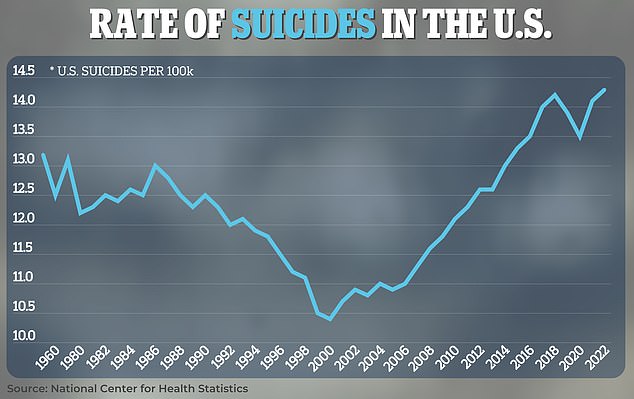The United States has the sixth-highest suicide rate in the world, a grim ranking that comes amid a decades-long rise in suicides over the past three decades.
A global ranking conducted by the international prescription service Universal Drugstore included South Korea as the country with the The highest rate suicides in men and women, with Croatia and Australia tied for number 10.
Suicide has become the 10th leading cause of death in the United States. Rates rose 16 percent between 2011 and 2022, with 2022 seeing the highest rate yet, with a record 49,369 suicide deaths.
The suicide rate in the United States reached 14.1 deaths per 100,000 people, considerably lower than South Korea’s 24.1 suicides per capita, but significantly higher than Australia’s and Croatia’s 12.4 deaths per capita.
Suicide rates in the US hit a record high in 2022 with more than 14 deaths per 100,000 people

International prescription drug service Universal Drugstore ranked South Korea as the country with the highest suicide rate for both men and women, with Croatia and Australia tied for No. 10.
In the top 10 countries, men were more likely to commit suicide. In Latvia, men were almost eight times more likely to commit suicide than women, the highest proportion among the countries included in the list. On average, men were about four times more likely to commit suicide.
Behind South Korea was Lithuania, with a suicide rate per capita of 18.5, followed by Slovenia, with 15.7 deaths per capita.
Behind Slovenia is Japan, with 15.4 deaths per 100,000, followed by Hungary, with 14.8 deaths per 100,000.
The United States, with 14.1 suicides per capita, was followed by Estonia, with a suicide rate per capita of 13.6.
Finland and Latvia ranked eighth and ninth with 12.9 and 12.7 deaths per capita respectively.
The researchers said: ‘South Korea had the highest rate of suicide deaths, at 24.1 per 100,000 people, followed by Lithuania, Slovenia, Japan and Hungary.
‘This suggests that cultural influences might play an important role in determining suicide rates, as all of these countries belong to two specific geographic regions: East Asia and Eastern Europe.’
They didn’t offer much of an explanation for the high rates, but they’re likely related to the stigma associated with mental health issues and seeking help in the form of therapy and medication.
South Korea and Japan have particularly stressful educational and work environments, as well as a social stigma around mental health, which may be increasing suicide rates there.
And post-Soviet countries have over the years experienced economic contractions and social transitions that have led to financial difficulties and social instability.

Suicide has become one of the top 10 causes of death in the United States amid record depression rates

CDC data shows the number of suicide deaths in 2022 is the highest on record, surpassing the next closest year (2018) by more than 1,000 deaths.
And in the United States, high rates of depression, as well as the availability of firearms, play a huge role in the rates of people who take their own lives.
Suicide rates in the U.S. tend to be higher in rural areas, likely because more than 60 percent of rural Americans live in an area with a shortage of mental health professionals, and more than 90 percent of psychologists and psychiatrists and 80 percent of social workers practice exclusively in metropolitan areas.
Mental illness has reached epidemic levels worldwide: approximately 280 million people suffer from depression, including five percent of the world’s adults and 5.7 percent of adults over the age of 60.
In the United States, the rate of people diagnosed with depression has reached 29 percent, up nearly 10 percentage points from 2015, according to Gallup.
And while men are more likely to commit suicide, women are more likely to be depressed: 37 percent of women report a depression diagnosis, compared with 20 percent of men.

The rate of people diagnosed with depression has reached 29 percent, almost 10 percentage points higher than in 2015.
Dr. Sarah Lipson, a professor of health policy at Boston University and principal investigator of the Healthy Minds Study, the largest and most comprehensive study of mental health in higher education, said the reasons for the record levels of suicide are multiple.
She said: ‘Some of the same reasons we’ve seen increases in the prevalence of depression, anxiety and other disorders can also be considered risk factors for suicide. Some of these include financial stress, uncertainty (around the economy, the job market and sociopolitical factors) and loneliness, which has changed dramatically over the past century, even if we remove the pandemic years.’
Suicide and depression rates are also increasing at a worrying rate among young adults and children, a trend that became exceptionally worse during the pandemic, when the public was forced to isolate themselves from friends and family.
He added: “And then there’s the media – how people are committing suicide in this country. We can’t talk about suicide and suicide prevention without talking about gun laws. Most suicide deaths occur with firearms and reducing access to firearms is an important way to prevent people from committing suicide.”
A poll by CNN and the Kaiser Family Foundation found that about half of parents said the pandemic had a negative impact on their children’s mental health, including 17 percent who said it had a “major negative impact.”
A CDC report analyzing youth mental health trends from 2011 to 2021 found that 13 percent of high school girls had attempted suicide, while 30 percent had seriously considered it. That number rose to more than 20 percent for LGBTQ+ teens, as 45 percent had seriously considered it.

